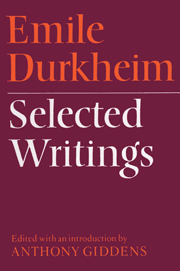Book contents
- Frontmatter
- Contents
- Preface
- Abbreviations
- Introduction: Durkheim's writings in sociology and social philosophy
- 1 The field of sociology
- 2 Methods of explanation and analysis
- 3 The science of morality
- 4 Moral obligation, duty and freedom
- 5 Forms of social solidarity
- 6 The division of labour and social differentiation
- 7 Analysis of socialist doctrines
- 8 Anomie and the moral structure of industry
- 9 Political sociology
- 10 The social bases of education
- 11 Religion and ritual
- 12 Secularisation and rationality
- 13 Sociology of knowledge
- Index
8 - Anomie and the moral structure of industry
Published online by Cambridge University Press: 05 August 2012
- Frontmatter
- Contents
- Preface
- Abbreviations
- Introduction: Durkheim's writings in sociology and social philosophy
- 1 The field of sociology
- 2 Methods of explanation and analysis
- 3 The science of morality
- 4 Moral obligation, duty and freedom
- 5 Forms of social solidarity
- 6 The division of labour and social differentiation
- 7 Analysis of socialist doctrines
- 8 Anomie and the moral structure of industry
- 9 Political sociology
- 10 The social bases of education
- 11 Religion and ritual
- 12 Secularisation and rationality
- 13 Sociology of knowledge
- Index
Summary
THE PROBLEM OF ANOMIE
The totality of moral rules truly forms about each person an imaginary wall, at the foot of which the flood of human passions simply dies without being able to go further. For the same reason – that they are contained – it becomes possible to satisfy them. But if at any point this barrier weakens, these previously restrained human forces pour tumultuously through the open breach; once loosed they find no limits where they can stop. They can only devote themselves, without hope of satisfaction, to the pursuit of an end that always eludes them. For example, if the rules of the conjugal morality lose their authority, and the mutual obligations of husband and wife become less respected, the emotions and appetites ruled by this sector of morality will become unrestricted and uncontained, and accentuated by this very release; powerless to fulfil themselves because they have been freed from all limitations, these emotions will produce a disillusionment which manifests itself visibly in the statistics of suicide. In the same way, should the morality governing economic life be shaken, and the search for gain become excited and inflamed beyond bounds, then one would observe a rise in the annual quota of suicides. One could multiply such examples. Furthermore, it is because morality has the function of limiting and containing that too much wealth so easily becomes a source of immorality. Through the power wealth confers on us, it actually diminishes the power of things to oppose us. Consequently, it lends strength to our desires and makes it harder to hold them in check.
- Type
- Chapter
- Information
- Emile Durkheim: Selected Writings , pp. 173 - 188Publisher: Cambridge University PressPrint publication year: 1972
- 2
- Cited by

